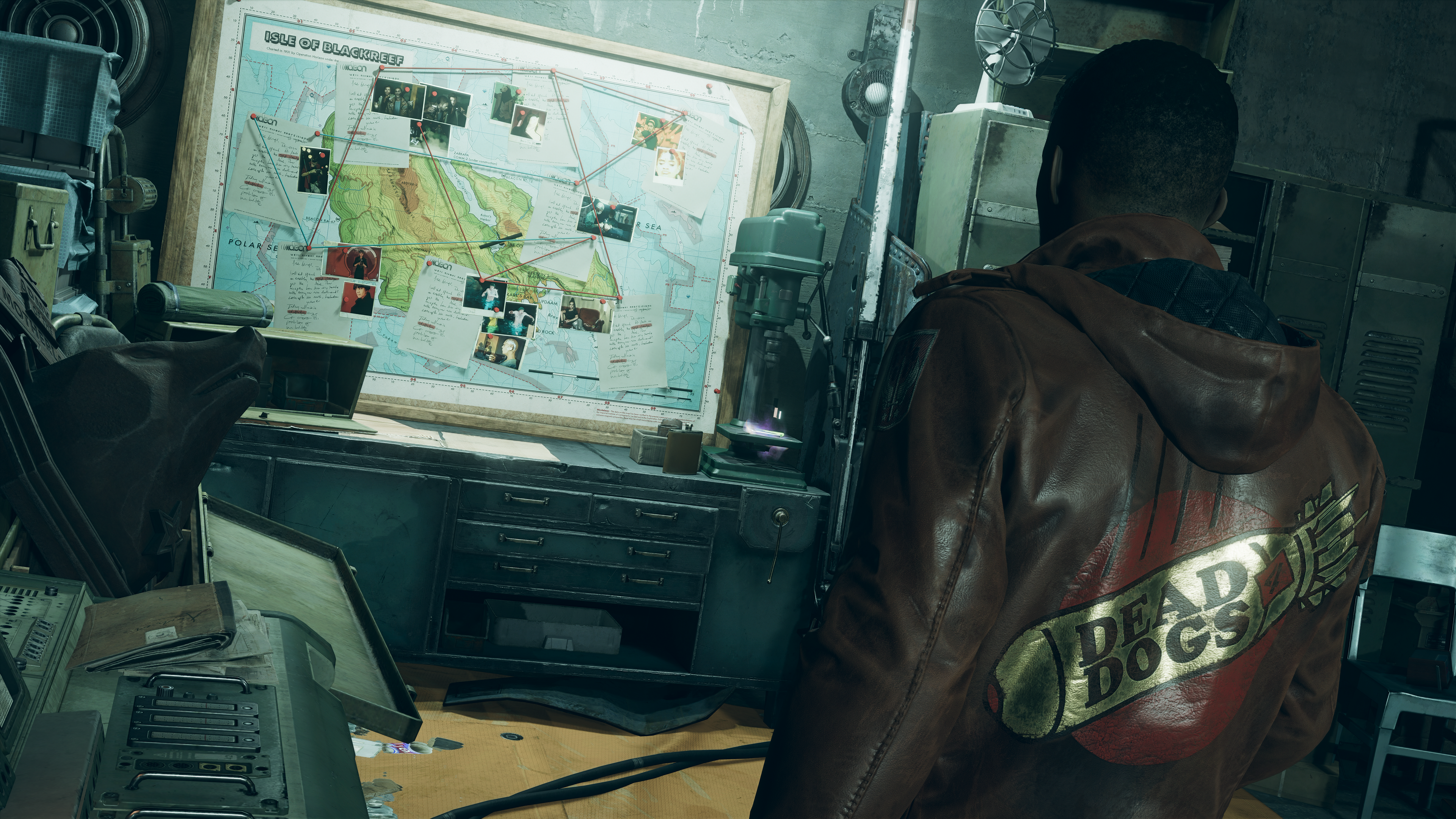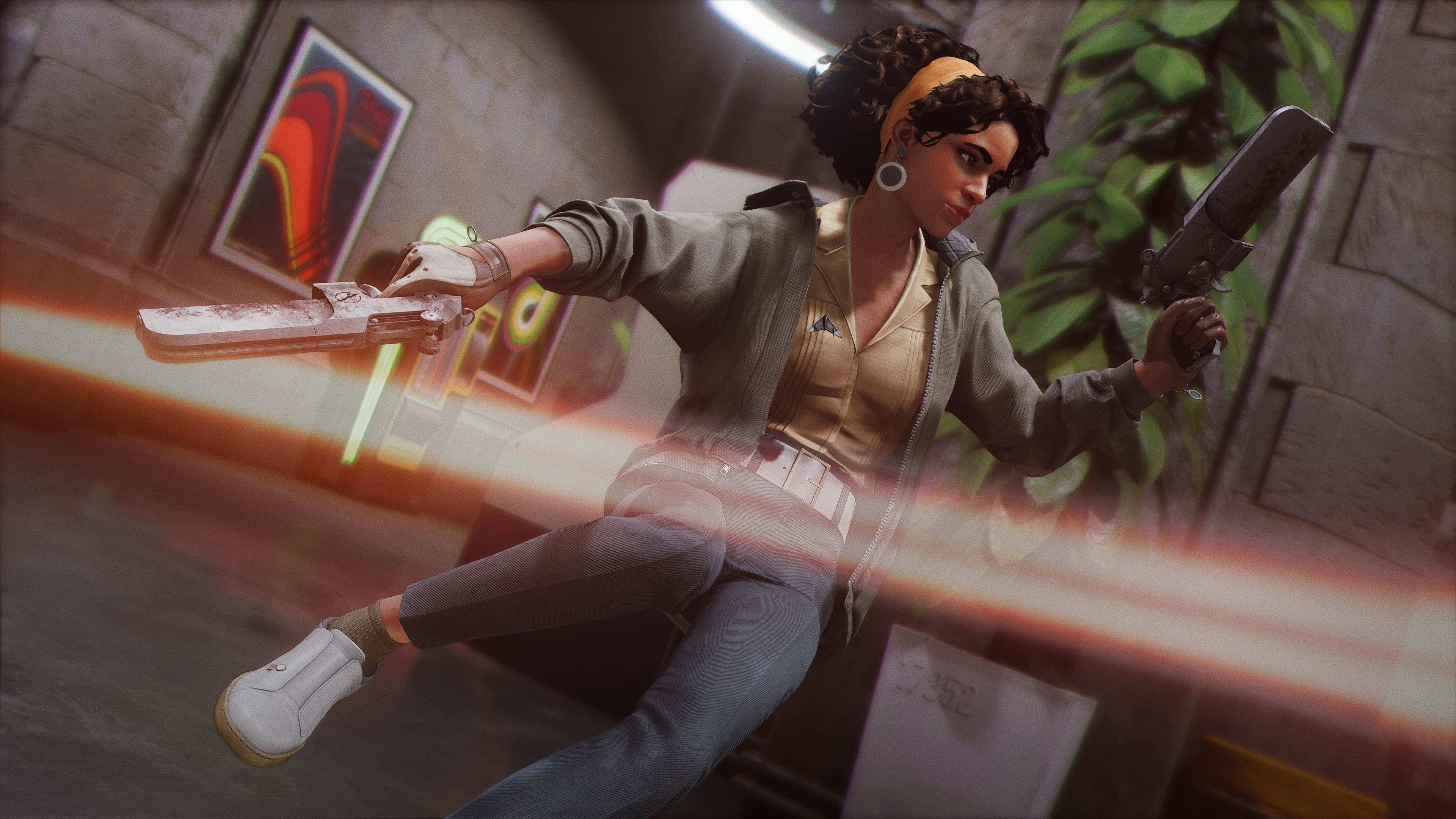Deathloop’s got a great elevator pitch. It’s a murder mystery with a time travel twist. You’re trapped on an island locked in an infinite time loop, with you and its denizens forced to repeat the same day over and over. The only way out is to track down eight targets, found somewhere in the four districts that divide the island. Assassinating all before one loop ends breaks it for good. But while you see the loop as a curse to be lifted, your intended kills see it as an endless, consequence-free party. As such they, and nearly everyone else on the island, will attempt to kill you on sight. And that includes your worst enemy and equal, who can be controlled by another player online. They have a single goal: protect the loop by ending you before you end it. Die, and your day starts again.
The original concept, created while Arkane was working with MachineGames on 2019’s Wolfenstein: Youngblood, would offer a diverse tool set, player freedom to experiment, and an architecturally coherent, intricate world to explore. A continued adherence to the defining principles of the studio’s previous works. The focus however, would be on replayability. The studio soon found itself eager to include “a big story”, character development, a rich world, an adventure arc – all also defining characteristics of its past games. “How could we build familiarity in a very focused, intimate space?” asks creative director Dinga Bakaba rhetorically. The solution: break time. The 60’s-style setting and “the impossible task” – eight assassinations in a single day – crystalised soon after.
Time to kill
Colt starts the day equipped with little more than “a cool jacket, a horrible hangover and a rusty SMG.” The rules of the loop and your place in it are quickly and violently explained. A better arsenal, including traditional weaponry (that’s customisable) and unique powers, need to be recovered as you explore the island from those you’ve bested in firefights or caught unawares. Discovery of two loopholes make your death less severe. One will allow you to carry over certain things between loops. The second is Deathloop’s own spin on respawns. Reprises give you three chances per loop to continue, and by finding your previous downed self you recover all items collected up to their (your?) untimely death.
“He is, I think, perpetually funny, surprising, charming,” says Bakaba of Deathloop’s protagonist Colt. “I think this is a guy who copes with those tragic events with self-deprecation and ‘dad’ jokes. He has flair, is very confident. He can just throw out these jokes, approach the situation with a lot of confidence.”
Colt’s nimble. Necessary when the world’s out to kill you and you’ve spaces to explore. Blackreef’s world design clearly shows Arkane’s continued love of verticality and, by association, powers that tap into superhuman exploration (“It’s really important to us,” says Art Director Sebastien Mitton. “Without powers, I always feel like I’m stuck on the ground. I’m frustrated”). As a result, each district is a dense sprawl. “Imagine a level like Dishonored 2‘s Edge of the World, and made even bigger, that’d give you an idea,” explains Bakaba of the expected scale for each.
It’s also worth noting that while the game day doesn’t play out in real time, there are four distinct time periods across the 24-hour day. There are different stories and activities playing out in each district for every time period, while what areas you can access and your routes through them can alter. The location of your targets, the Visionaries, also vary depending on the time of day you visit.
While a quick menu selection can freely switch you between times, actions in one time period can have repercussions in another. The studio is cagey about story details, but offers one eventuality to illustrate: a character saved earlier in the day will unlock a door somewhere else later, giving you access to a new part of the island.
From soldier to assassin
In Deathloop, frontal assaults are possible yet not advised. Mapping out areas and enemy positions first allows you to plan out attacks or routes that increase your survival chances. Simultaneously you could (and should) eavesdrop on important conversations and discover hidden spots that’ll help your objectives. As example: if everyone is wearing a mask, how do you pinpoint your target? Or another: can you take out a target without alerting anyone?
Aggressive measures do come into play as well. Alongside a tool to hack tech like turrets, collectable Trinkets grant weapon upgrades and customisations. Slabs are items of power, each of which grant a unique ability. Not all are traversal-based: Kinesis is the obvious early headliner, letting you toss enemies into the air or against walls (or each other) with a wave of your hand. Find which works best for your playstyle: your loadout is limited to three weapons and two powers, the latter of which can have two upgrades. (Upgradable by assassinating the same target on a subsequent loop).
Deathloop was an early example of what was possible with the DualSense wireless controller. Bakaba explains every weapon will have a slightly different feel. “You mentioned the trigger locking to represent your gun jamming. But when you’re out of ammo, the trigger effect will disappear. Even before your brain registers it, the animation, the click-click sound, you’ll know you’re out.”
It’s all about having fun with the toolbox, combining and seeing what results. “By the end of the game you’re kind of a demigod,” says Bakaba. And player choice is key. If you really want to, you can try and complete the game with “just that rusty SMG and whatever you find on your way and accept you will lose everything at the end of each loop. It’s entirely up to you as a player.”
But not all things are in your control. Enter Julianna.
Meet your worst enemy
Julianna began life as one of your targets. Even early in development, she was distinct. While her fellows would be self-involved and let others do their dirty work, Julianna was driven, actively trying to take you out first. It turned one of Blackreef’s elite – its Visionaries – into your equal and would challenge you to outfox her. That drive is still core to her character. But she only became fully realised, and ultimately co-lead on the game’s cover art, when someone within the studio suggested she could be a playable character.
“I wouldn’t say a eureka moment,” responds Bakaba when I ask him and Mitton if that idea changed the trajectory of what the game could be. “It was a crossroad. It’s not just adding an enemy type […] it was definitely a turning point.”
One initial concern was the technical impact of a second, player-controlled character in the world. Multiplayer could mean compromising on Arkane’s vision of Blackreef’s NPC density or the scale of the island’s level design. Fears were put to rest once the studio learned about the speed of PS5’s CPU. “It gave us oxygen,” says Mitton simply.
Even without player control, Julianna is a constant presence. She continually harasses Colt, either from afar, haranguing him through the world’s multitude of tannoys and speaker systems, or up close even as she attempts to kill him. To be fair, Colt quickly starts giving back as good as he gets, energetic verbal clashes that, as Bakaaba puts it, are a “contest of punchlines” and ones he’s eager to see players react to.
Those barbs are surprisingly good-natured in their delivery. Attempted murderer she may be, there’s no vindictiveness or vengefulness to Julianna. She’s playful. For someone trying to kill me, she’s incredibly likeable.
“It’s a harsh island,” Bakaba responds when I ask him about the contradiction of someone I want to know better yet maintain a safe distance from. “People came here for an eternal party. They brought a cocoon of fun, comfort and technology to turn all this dreariness into an entertainment resort. If Julianna is going to be someone who wants to protect the loop, she has to buy into that philosophy. That this is harmless, this is fine. This is even fun. She’s a very complex, interesting character.”
The best assassins know the importance of keeping a low profile.
A unique klaxon will sound in your game to signal a player-controlled Julianna has appeared. The creative director runs down a list of possible scenarios that could result: a Julianna who will mess with a player’s head but never be seen, another who’ll spook you with jumpscares by appearing and disappearing at random. Even a ‘friendly’ one who’ll drop off weaponry for you to use. Who Julianna is will be up to you. “She’s eternal. She doesn’t care about dying. She cares about the hunt and how she can make it interesting over an eternity.”
Pulling off the perfect takedown is one thing. The unpredictability of psychological warfare while trying to complete eight assassinations though? I’m already intrigued to see what’ll result when Deathloop launches later this year.
Source: Playstation Blog
—


